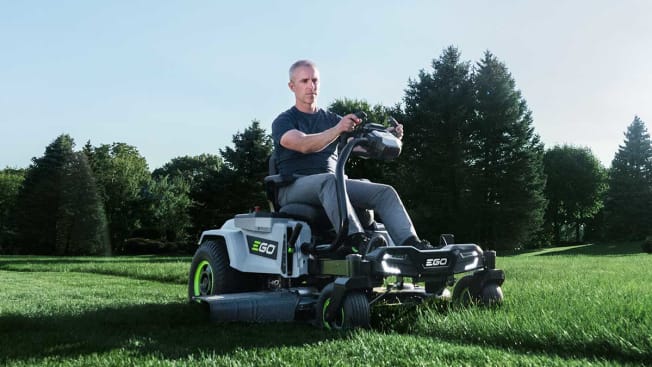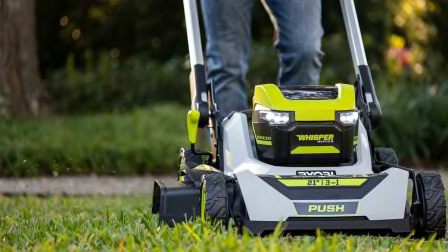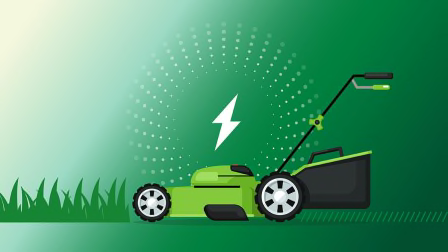Best Battery Riding Lawn Mowers of 2025
We tested electric riding mowers from John Deere, Ego, Greenworks, and Ryobi. Here are the top-performing models.
When you shop through retailer links on our site, we may earn affiliate commissions. 100% of the fees we collect are used to support our nonprofit mission. Learn more.

Electric riding lawn mowers have grown in popularity. Mainstream companies have even jumped on the battery bandwagon over the past couple of years. John Deere, for example, which has long dominated the market for gas mowers, recently debuted a new battery riding mower in a market that’s already teeming with quality riding mowers from brands like Ego, Greenworks, and Ryobi.
Best Battery Riding Lawn Mowers
We’ve listed eight of the best electric (battery) riding lawn mowers we’ve tested. Most are zero-turn-radius mowers, but two lawn tractors also make the cut. Battery riding mowers are too new a category for us to judge long-term predicted reliability or owner satisfaction.
Why Buy an Electric Riding Lawn Mower?
Battery riding lawn mowers are generally more expensive than their gas counterparts—but not always. In fact, the top-rated battery riding mower in our ratings (a ZTR from Ego) is actually about $2,000 less than the top-rated gas ZTR. And it scores 3 points higher.
What are the other benefits of a battery riding mower? You’ll typically get a quieter ride than with a gas model. You’ll also save on gasoline and help the environment in the process. In addition, “battery riding mowers don’t take as much effort to maintain,” says David Trezza, who leads lawn mower testing for Consumer Reports.
As with a gas-powered model, you’ll have to keep the blades sharp and your eye on the tire pressure. But you won’t need to change the spark plugs or motor oil, or add new gasoline and stabilizer.
“You may need to recharge the battery periodically during the winter,” Trezza says. “It can get damaged if it stays discharged or is exposed for too long to extreme cold—or heat, for that matter.” Check the manual or maker’s website for specific care instructions.
What's Available in Battery Riding Lawn Mowers
As with gas riding mowers, battery riding mowers come in three types:
Traditional lawn tractors: These have car-style steering wheels and cutting decks from 42 to 54 inches.
Zero-turn-radius mowers: Their cutting decks also range from 42 to 54 inches. Most use levers for forward and rearward steering to enable nimble handling and tight turns. More than half of the electric riding mowers in our tests are of this variety.
Rear-engine riders: These lower-cost compact units typically have 30-inch-wide cutting decks.
As far as features, battery riding mowers are generally on a par with gas riding mowers. All of the battery models in our ratings can cut in reverse. And they include gauges you can view from your seat to see how much battery juice remains. Other available features include cruise control, washout ports, and suspension seats for greater comfort.
All of the models in our ratings have warranties of at least three years, though you can find warranties as long as five years. Battery-powered riding mowers haven’t been on the market long enough for Consumer Reports to score them for owner satisfaction or reliability.
How CR Tests Lawn Mowers
To get ratings and reviews of the latest models by early spring, we travel to our mower testing facility in Fort Myers, Fla., to conduct tests in late winter at grounds we prepare each year.
We plant 1,800 pounds of grass seed (predominantly annual rye, prized for its dense growth) and cut 500,000 square feet of grass in three modes (mulching, side discharging, and bagging), producing a total of 3,000 pounds of clippings. We mow both level turf and slopes to get a feel for each model, and we review their convenience features.
Each model’s Overall Score incorporates all of that performance data along with predicted reliability and owner satisfaction ratings from our latest member surveys, although we don’t currently have enough data on battery riding mowers to incorporate reliability and satisfaction scores. For gas-powered models, we leverage data on more than 46,807 lawn mowers owned by 39,051 CR members that were purchased new between 2014 and 2024.
For models with noise-at-ear ratings that are unsatisfactory—or less than satisfactory—we recommend that you wear hearing protection. Also, CR doesn’t judge zero-turn-radius mowers for bagging because our research shows that just 11 percent of their users bag their clippings.






























